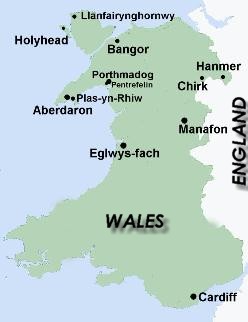
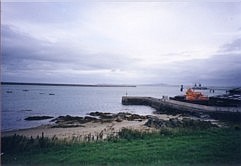
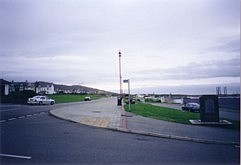
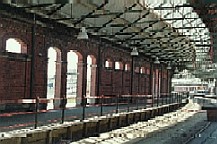
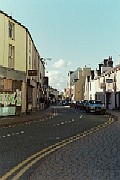
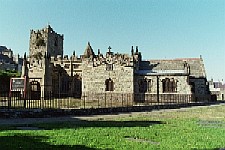
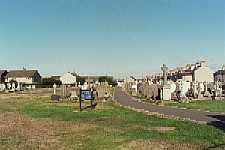
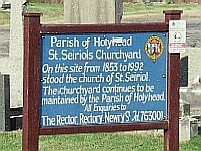

|

|

|

|
 |

|

|

|
R.S.Thomas's father got a job on the cross-channel boats between Holyhead and Ireland. So R.S. and his family reached Holyhead just before Christmas of 1918. It was raining on the day they arrived. But on the next day, the weather cleared up, and he was impressed very much with the blue sky and the bluer sea.
R.S. spent his boyhood here. He, before moving to this place, had been so weak that his life without doctor had not been imagined. Yet he was fascinated at the nature and liked to play outside. He would gather flowers in the spring, go to swim in the sea in the summer and gather mushrooms in the autumn. As a result, playing in the nature improved his health and he got stronger.
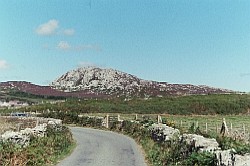 |
taken near Penhros Feilw in 2003 |
English was his first language, as his parents were the English-speaking Welsh (his father might have spoken Welsh in his boyhood but abandoned it when he began his career as a sailor). So he was raised and educated in English, although he was living in Wales. In those days the teachers at the school thought it was better to educate the children in English, rather than in Welsh.
It was this time that he began to write poems, and he took Welsh in the first year in secondary school. Unfortunately, he did not take it seriously, and could not acquire the language entirely at the time.
There were two Anglican churches in this village centre. He went to one of them, St. Seiriol's Church, just because services there were given in English. The services of the other, St. Cybi's church located very close to the centre, were in Welsh but none of his family could speak in Welsh.
His father spent much of the time at the sea. His father's ears gradually got worse, because of his work on the noizy ships, and finally, he became deaf so he gave up his dream to be a captain. He also had a beautiful voice derived from his mother, i.e., R.S.'s grandmother, and liked music. He had had some recitals at Dublin. It is said that Beethoven who was nearly deaf composed his pieces because he knew musical theories but he could not listened to it so he did not conduct an orchestra. Who can sing without his ears? Nobody can't. R.S.'s father's deafness deprived him of, not only his dream, but his avocation to listen to music. R.S. happened to see his father press his ear against his radio speaker and manage to listen to his favorite songs. R.S. felt sad. R.S. wanted not to be like his father. His mother, whose foster parent had been a vicar, recommended him to take holy orders. He had no choice. He received it.
He left Holyhead in the summer of 1931. He alone moved to Bangor to go to the University of Wales, Bangor. His parents remained in Holyhead until their death.
2002: I visited Aberdaron for the first time with my two companions.
In August, 2002, after finishing my research at the University of Wales, Bangor, I left for Holyhead with my travelling companions. Before we left, it had been raining heavily, but it soon stopped and turned cloudy. When we reached Holyhead, the strong winds constantly blew, and we found it much colder in Holyhead than in Bangor. The bleak shore impressed me strongly. After taking some photos, we had to rush back to Bangor. I was very disappointed in such a short stay, but we had to return before nightfall
.
2003: I visited there again by myself.
I had taken a ferry from the Dublin Ferry Port at one noon in August and arrived at Holyhead just after two hours. How faster it sailed than it took the half a day in about one century ago!
After a little bit longer queston at the immigration control at the ferry port -- as you know, it is always longer at immgration in U.K. than in other countries-- , I was standing alone at the station next to the port. It was a very fine day and I felt hot although it had been rather chilly the last year. I also planed to stay there for one night, that meant I had much time to spend there, unlike the last year. Yes, nothing was the same as the last year. Wan't it like R.S.'s first arrival at Holyhead?
Anyway, I checked in a B&B at the first, then looked for two churches in this village. I took some photos, a gentle man explained to me why St. Seiriol's Church had been broken and a woman from England told me how much she liked Holyhead. Winds blew constantly in any part of this village but the shining sun and villagers' smiles kept me warm; I had a very delicious battered cod at a pub, took an unexpected lesson of the Welsh pronunciation from the hostess of the B&B, a native Welsh speaker from this village, etc, etc... I have happy memories there in this one day.
The next day, I checked out, rented a car at the station, and set out for Penhros Feilw and Llanfairynghornwy by car by myself.
Holyhead is the largest town on Anglesey and has the railway terminal station close to the town centre. Since 19th century it also has been the main port connecting Wales and Ireland. Holyhead's costal area is ideal for visiting, as 26 beaches have received cleanliness awards. According to a leaflet, 62% of people on Anglesey speak Welsh as their first language.
St. Cybi's church is located in the very centre of Holyhead, and you can find it so easily. It is said the walls of the church were the fort built by the Romans in 4th century to prevent attacks from sea riders. The building of St. Seiriol's Church was broken in 1992 and only the churchyard is used as a graveyard at present.
Not only the churches, but there are many historic sites in Holyhead. For example, Caer y Twr & the Roman Watchtower and Penhos Feilw Standing Stones are worth to visit.
 Bangor
Bangor